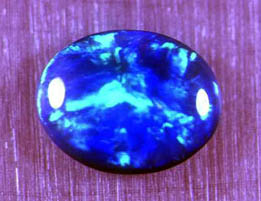
|
THE OPAL
- COMPOSITION
& STRUCTURE
Opals
were considered for many years amorphous silicon with a water
content in between 2 to 20%.
The
use of modern techniques with x rays and electronic microscopes has
proved that opals are formed by tiny lepisferas disposed in
successive layers of kristobaliitia and tridimita, with same size,
packaged in compact structures. Therefore, is not shapeless but
semicrystalline. The Opal with high quality is then called Opal C-T
( kritobaliitia-tridimita ).
- VARIETIES
& COLOURS
From the mineralogical point of vie there are two main
varieties of Opal: Common and noble. The first has not great range
of colours and when is observed against the light has not got beauty.
On the other hand, the noble can be transparent, translucent, or
even opaque, although some of them present lack of colours variety,
they usually show great range in tones that gives their magical
beauty calling quickly your attention.
This
effect called game of colours, should not be mistaken with the
opalescence, that happens in the noble opal acting over the parcels
of lepisferas like diffraction grilles, the size of the spheres and
the light angle of incidence, creates the changing colours effect:
from violet to red, green or blue.
The
colour of the opal (apart from
the game of colours) can be black, grey, white, brown, purple,
yellow, orange, green, greenish blue, or colourless. It can be
almost transparent, slightly opalescent up to opaque.
Varieties
from the gemmological pint of view:
- White
Opal: with game of colours, translucent or semi translucent. It
can be white, greyish, yellowish, at times turbid and milky.
- Black
Opal: with game of colours, it can be opaque, dun black or
greenish. Is the most appreciated due to beauty and rarity, the
good ones reaching high prices in market much higher than the
other opals.
- Opal
of water: with a poor game of colours transparent or semi
transparent. It can be colourless or yellow pale.
- Opal
of fire: both with or without game of colours. Transparent and
semi transparent. It can be yellow,
- Hydrophane:
Translucent, milky and very porous. When is introduced in water
becomes more transparent, some of them shows slightly game of
colours features.
- Matrix
opal: Opal that holds part of the mother rock, usually located
in the base with the aspect of brown reddish tiny veins. Many
experts consider it is not a real variety, just a form of
presentation.
Boulder
opal (in rock only): with game of colours, too thin to be carved
remains in the mother rock.

- Coloured
opals: without game of colours, translucent. Great variety of
colours, green, yellow, cherry, bluish, etc..
- Hyalite:
without game of colours, transparent and colourless.
However,
there is a wide list with commercial names according to the pattern,
shape, and game of colours, many times incorporated in the gemmological
designation as if really were part of it. In that list we can highlight.
·
Harlequin
opal: imitating rhombus effects.
·
Floral
opal: effects in leaves shape.
·
Starred
opal: effects of a sky
starred.
·
wave
opal: imitating the waves effects
- PHYSICAL
GENERAL PROPERTIES
-
Hardness: Low hardness from 5 to 6.5 in the Mohs scale is very
fragile any single knock, or change in temperature can break it.
Moreover, water evaporation can cause cracks subtracting value and
beauty, happening even to disappear the game of colours.
-
Exfoliation & Fracture: Because of its shapeless, do not show
any exfoliation. The fracture is concoidea.
-
Specific gravity: Very
low and variable 2.0/2.25.
- OPTICAL
GENERAL PROPERTIES
-
Brightness: Vitreous, sometimes resinaceous or waxen.
-
Transparency: As seen before, from very transparent to opaque.
-
Refraction: Is optically isotropic due to its shapeless. The
refraction index is low, around 1450.
- BEHAVIOR
TO LOW-RANGE RADIATION.
-
Luminescence under long UV light: Opals presents white
fluorescence. Opals with uranium in its composition can show green
fluorescence. The opal of fire, sometimes displays fluorescence red or
green. Opals of water and blacks are inert.
-
Luminescence under low UV light:
In general, the answers to low range UV light are more intense
than to long range UV light.
|
![]()